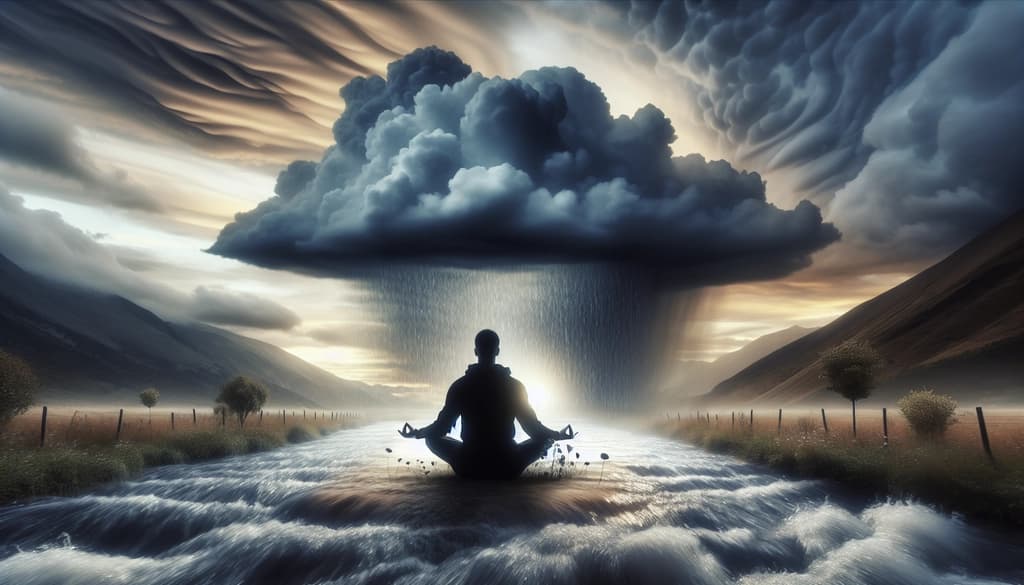How to Stop Struggling with Life: Finding Stillness in the Heart of Chaos

The Endless Search for Peace: Why We Struggle
Life moves unpredictably—sometimes as gentle as spring winds, sometimes as fierce as winter storms. Our hearts yearn for calm, for certainty, for some soft ground beneath our feet. But how often does this yearning turn into a tightness in the chest, a feeling of swimming upstream, questioning how to stop struggling with life?
Struggle comes when we resist what is: a disagreement with the reality unfolding. It can show up as tension, blame, or the desperate wishing for circumstances to be different. Yet in chasing after control, we find ourselves caught—tangled in hopes, regrets, and endless inner dialogue.
What if it is not the chaos itself, but the grasping for escape, that creates our deepest suffering? If you find yourself wondering deeply about the roots of your struggle, you might also explore the question why do we suffer, as it gently touches the heart of our human experience.
The Truth of Impermanence and the Quiet Doorway Within
Beneath the noise of striving, there is a quieter truth: all things change. This is the heart of impermanence. Emotions rise and subside, days darken and brighten, and even our sense of struggle ebbs and flows.
If you pause, feeling your breath softly enter and leave the body, you might sense this in your own experience. Hurts and worries, no matter how vast, eventually pass. The practice becomes this: not turning away from the storm, but letting each wave wash through, trusting that even the fiercest surge will subside.
This teaching echoes through many contemplative traditions. The Four noble truths explained can illuminate how our resistance to impermanence continues the struggle—and how acceptance can bring relief.
You might try placing a hand on your chest, noticing the warmth, the rise and fall, meeting each moment as you would welcome a friend—curiously, gently, without the usual need to fix or fend off. In those tender pauses, you may stumble upon the meaning of dukkha, the universal sense of dissatisfaction that binds us all, and realize its impermanent nature.
How to Find Stillness in Chaos
Stillness does not mean stopping the world’s motion, nor erasing your pain or confusion. Rather, it is a willingness to rest in the space beneath the swirl. Sometimes this stillness is only a flicker—a single breath, a sense of ground beneath your seat, a moment when you notice your hands unclenching.
You might sit quietly, feeling the movement of your thoughts like leaves on a stream, watching each thought, plan, or fear drift by. You do not need to grasp or chase; simply notice, soften, and return to the gentle rhythm of breathing.
If you are walking, notice your feet meeting the earth, the pressure and release. If you are in conversation, feel the air moving across your skin, the sound of your own voice. Each moment is an invitation to pause, to anchor in the real time of now. Often, as we watch the dance between desire and struggle, we can see the desire and suffering connection that shapes our experience of chaos.
Meeting Internal Struggle with Kindness
It is understandable—so human—to try to wrestle discomfort away. But sometimes, the deepest relief is found not by fighting, but by surrendering to the tides of experience with tenderness. The practice is not self-improvement, but self-compassion.
You might place your hand where tension gathers—belly, jaw, shoulders—and breathe. Let the parts of you that struggle know they are seen, welcomed, not exiled. In this welcoming, something begins to loosen; the grip relaxes, the heart softens. This is how to dissolve internal struggle—not by force, but by allowing everything to belong.
Sometimes, it is in letting go of the struggle to control or escape that a deeper stillness arrives. The practice of letting go of attachment can be a gentle door into acceptance and peace.
"One morning, as rain pelted her window, she finally stopped arguing with the storm. Curling up in its music, she felt the warmth in her own chest, and for the first time in days, the world outside seemed less frightening. Struggle had cracked open into space."
The Wider Impact: Living the Wisdom of Impermanence
When you absorb the truth of impermanence deep in your bones, resistance softens. Challenges remain, but they arrive as weather—passing over you, not defining you. Relationships shift, moments break open, dreams dissolve and are born again, but your capacity to remain present, to greet each state with honesty, grows.
Scientific research tells us that mindfulness practices lower anxiety and increase resilience—but even more, the lived experience reveals a new gentleness with yourself and those around you. Creativity, patience, and clarity begin to unfurl. Not because life is suddenly easy, but because you learn to stop gripping so tightly to what will change anyway.
For some, there may arise the wish to know the very heart of freedom from struggle—as expressed in the idea of what is moksha, or ultimate liberation. If your curiosity leads there, let it be with a patient and gentle mind.
If you wish to delve further into pathways of liberation, reflecting on how to end suffering may offer you additional insight and solace.
Returning to This Moment
May you allow struggle to soften—like ice melting into water, like a clenched fist opening to the sky. May you breathe into the waves, remembering that each sensation, each difficulty, is only a visitor, not a prison. In the heart of chaos, may you find moments of stillness, and in the truth of impermanence, a gentle freedom.
